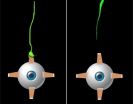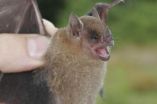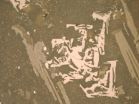(Press-News.org) Imagine you cannot move your eyes up, and you cannot lift your upper eyelid. You walk through life with your head tilted upward so that your eyes look straight when they are rolled down in the eye socket. Obviously, such a condition should be corrected to allow people a normal position of their head. In order to correct this condition, one would need to understand why this happens.
In a paper published in the April 16 print issue of the journal Neuron, University of Iowa researchers Bernd Fritzsch and Jeremy Duncan and their colleagues at Harvard Medical School, along with investigator and corresponding author Elizabeth Engle, describe how their studies on mutated mice mimic human mutations.
It all started when Engle, a researcher at the Howard Hughes Medical Institute (HHMI), and Fritzsch, professor and departmental executive officer in the UI College of Liberal Arts and Sciences Department of Biology, began their interaction on the stimulation of eye muscles by their nerves, or "innervation," around 20 years ago.
Approximately 10 years ago, Engle had identified the mutated genes in several patients with the eye movement disorder and subsequently developed a mouse with the same mutation she had identified in humans. However, while the effect on eye muscle innervation was comparable, there still was no clue as to why this should happen.
Fritzsch and his former biology doctoral student, Jeremy Duncan, worked with the Harvard researchers on a developmental study to find the point at which normal development of eye muscle innervations departs from the mutants. To their surprise, it happened very early in development. In fact, they found—only in mutant mice—a unique swelling in one of the nerves to the eye muscle.
More detailed analysis showed that these swellings came about because fibers extending to the eyes from the brain tried to leave the nerve as if they were already in the orbit, or eye socket. Since it happened so early, the researchers reasoned that something must be transported more effectively by this mutation to the motor neurons trying to reach the orbit and the eye muscles; something must be causing these motor neurons to assume they have already reached their target, the orbit of the eye.
To verify this enhanced function, the researchers developed another mouse that lacked the specific protein and found no defects in muscle innervation. Moreover, when they bred mice that carried malformed proteins with those that had none of these proteins, the mice developed a normal innervation.
This data provided clear evidence of what was going wrong and why, but it did not provide a clue as to the possible product that was more effectively transported in the mutant mice and, by logical extension, in humans. Further analysis revealed that breeding their mutant mice with another mutant having eye muscle innervation defects could enhance the effect of either mutation.
With this finding, they had identified the mutated protein, its enhanced function, and at least some of the likely cargo transported by this protein to allow normal innervation of eye muscles. This data provides the necessary level of understanding to design rational approaches to block the defect from developing.
Knowing what goes wrong and at what time during development can allow the problem to be corrected before it develops through proper manipulations. Engle, Fritzsch, and their collaborators currently are designing new approaches to rescue normal innervation in mice. In the future, their work may help families carrying such genetic mutations to have children with normal eye movement.
INFORMATION:
The title of the Neuron paper is "Human CFEOM1 Mutations Attenuate KIF21A Autoinhibition and Cause Oculomotor Axon Stalling."
The research was supported by a National Institutes of Health (NIH) grant to Engle and colleague Fritzsch and HHMI funding to Engle.
Researchers track down cause of eye mobility disorder
Normal development stalls in the nerves
2014-04-16
ELSE PRESS RELEASES FROM THIS DATE:
Scientists observe quantum superconductor-metal transition and superconducting glass
2014-04-16
The article "Collapse of superconductivity in a hybrid tin–grapheme Josephson junction array'" (authors: Zheng Han, Adrien Allain, Hadi Arjmandi-Tash,Konstantin Tikhonov, Mikhail Feigelman, Benjamin Sacépé,Vincent Bouchiat, published in Nature Physics on March 30, 2014, DOI:10.1038/NPHYS2929) presents the results of the first experimental study of the graphene-based quantum phase transition of the "superconductor-to-metal" type, i.e. transformation of the system's ground state from superconducting to metallic, upon changing the electron concentration in graphene sheet.
The ...
Stanford scientists develop 'playbook' for reverse engineering tissue
2014-04-16
STANFORD, Calif. — Consider the marvel of the embryo. It begins as a glob of identical cells that change shape and function as they multiply to become the cells of our lungs, muscles, nerves and all the other specialized tissues of the body.
Now, in a feat of reverse tissue engineering, Stanford University researchers have begun to unravel the complex genetic coding that allows embryonic cells to proliferate and transform into all of the specialized cells that perform myriad biological tasks.
A team of interdisciplinary researchers took lung cells from the embryos of ...
Red moon at night; stargazer's delight
2014-04-16
Monday night's lunar eclipse proved just as delightful as expected to those able to view it. On the East Coast, cloudy skies may have gotten in the way, but at the National Science Foundation's National Optical Astronomy Observatory (NOAO) near Tucson, Ariz., the skies offered impressive viewing, as seen from the pictures provided here.
Nicknamed a "blood moon," this lunar eclipse's color was similar to the majority of lunar eclipses. This has to do with the Earth's atmosphere's propensity for longer-wavelength light (e.g., the reds, oranges and yellows seen in sunrises ...
Information storage for the next generation of plastic computers
2014-04-16
Inexpensive computers, cell phones and other systems that substitute flexible plastic for silicon chips may be one step closer to reality, thanks to research published on April 16 in the journal Nature Communications.
The paper describes a new proposal by University of Iowa researchers and their colleagues at New York University for overcoming a major obstacle to the development of such plastic devices—the large amount of energy required to read stored information.
Although it is relatively cheap and easy to encode information in light for fiber optic transmission, ...
Two new species of yellow-shouldered bats endemic to the Neotropics
2014-04-16
Lying forgotten in museum collections two new species of yellow-shouldered bats have been unearthed by scientists at the American Museum of New York and The Field Museum of Natural History and described in the open access journal ZooKeys. These two new additions to the genus Sturnira are part of a recent discovery of three bats hidden away in collections around the world, the third one still waiting to be officially announced.
Up until recently the genus Sturnira was believed to contain only 14 species. In the last years closer morphological and molecular analysis have ...
Researchers: Obesity can amplify bone and muscle loss
2014-04-16
TALLAHASSEE, Fla. – Florida State University researchers have identified a new syndrome called "osteosarcopenic obesity" that links the deterioration of bone density and muscle mass with obesity.
"It used to be the thinking that the heavier you were the better your bones would be because the bones were supporting more weight," said Jasminka Ilich-Ernst, the Hazel Stiebeling Professor of Nutrition at Florida State. "But, that's only true to a certain extent."
The syndrome, outlined in the May issue of Ageing Research Reviews, explains how many obese individuals experience ...
Researchers develop a new drug to combat the measles
2014-04-16
A novel antiviral drug may protect people infected with the measles from getting sick and prevent them from spreading the virus to others, an international team of researchers says.
Scientists from the Institute for Biomedical Sciences at Georgia State University, the Emory Institute for Drug Development and the Paul-Ehrlich Institute in Germany developed the drug and tested it in animals infected with a virus closely related to one that causes the measles. As reported in the current issue of the journal Science Translational Medicine, virus levels were significantly ...
Celldex's Phase 1 study of CDX-1401 published in Science Translational Medicine
2014-04-16
HAMPTON, NJ (April 16, 2014): Celldex Therapeutics, Inc. (NASDAQ: CLDX) announced today that final data from its Phase 1 study of CDX-1401 in solid tumors, including long-term patient follow-up, have been published in Science Translational Medicine (Vol 6 Issue 232). The data demonstrate robust antibody and T cell responses and evidence of clinical benefit in patients with very advanced cancers and suggest that CDX-1401 may predispose patients to better outcomes on subsequent therapy with checkpoint inhibitors. CDX-1401 is an off-the-shelf vaccine consisting of a fully ...
Meteorites yield clues to red planet's early atmosphere
2014-04-16
Geologists who analyzed 40 meteorites that fell to Earth from Mars unlocked secrets of the Martian atmosphere hidden in the chemical signatures of these ancient rocks. Their study, published April 17 in the journal Nature, shows that the atmospheres of Mars and Earth diverged in important ways very early in the 4.6 billion year evolution of our solar system.
The results will help guide researchers' next steps in understanding whether life exists, or has ever existed, on Mars and how water—now absent from the Martian surface—flowed there in the past.
Heather Franz, ...
Mutant protein in muscle linked to neuromuscular disorder
2014-04-16
Sometimes known as Kennedy's disease, spinal and bulbar muscular atrophy (SBMA) is a rare inherited neuromuscular disorder characterized by slowly progressive muscle weakness and atrophy. Researchers have long considered it to be essentially an affliction of primary motor neurons – the cells in the spinal cord and brainstem that control muscle movement.
But in a new study published in the April 16, 2014 online issue of Neuron, a team of scientists at the University of California, San Diego School of Medicine say novel mouse studies indicate that mutant protein levels ...
LAST 30 PRESS RELEASES:
Numbers in our sights affect how we perceive space
SIMJ announces global collaborative book project in commemoration of its 75th anniversary
Air pollution exposure and birth weight
Obstructive sleep apnea risk and mental health conditions among older adults
How talking slows eye movements behind the wheel
The Ceramic Society of Japan’s Oxoate Ceramics Research Association launches new international book project
Heart-brain connection: international study reveals the role of the vagus nerve in keeping the heart young
Researchers identify Rb1 as a predictive biomarker for a new therapeutic strategy in some breast cancers
Survey reveals ethical gaps slowing AI adoption in pediatric surgery
Stimulant ADHD medications work differently than thought
AI overestimates how smart people are, according to HSE economists
HSE researchers create genome-wide map of quadruplexes
Scientists boost cell "powerhouses" to burn more calories
Automatic label checking: The missing step in making reliable medical AI
Low daily alcohol intake linked to 50% heightened mouth cancer risk in India
American Meteorological Society announces Rick Spinrad as 2026 President-Elect
Biomass-based carbon capture spotlighted in newly released global climate webinar recording
Illuminating invisible nano pollutants: advanced bioimaging tracks the full journey of emerging nanoscale contaminants in living systems
How does age affect recovery from spinal cord injury?
Novel AI tool offers prognosis for patients with head and neck cancer
Fathers’ microplastic exposure tied to their children’s metabolic problems
Research validates laboratory model for studying high-grade serous ovarian cancer
SIR 2026 delivers transformative breakthroughs in minimally invasive medicine to improve patient care
Stem Cell Reports most downloaded papers of 2025 highlight the breadth and impact of stem cell research
Oxford-led study estimates NHS spends around 3% of its primary and secondary care budget on the health impacts of heat and cold in England
A researcher’s long quest leads to a smart composite breakthrough
Urban wild bees act as “microbial sensors” of city health.
New study finds where you live affects recovery after a hip fracture
Forecasting the impact of fully automated vehicle adoption on US road traffic injuries
Alcohol-related hospitalizations from 2016 to 2022
[Press-News.org] Researchers track down cause of eye mobility disorderNormal development stalls in the nerves





